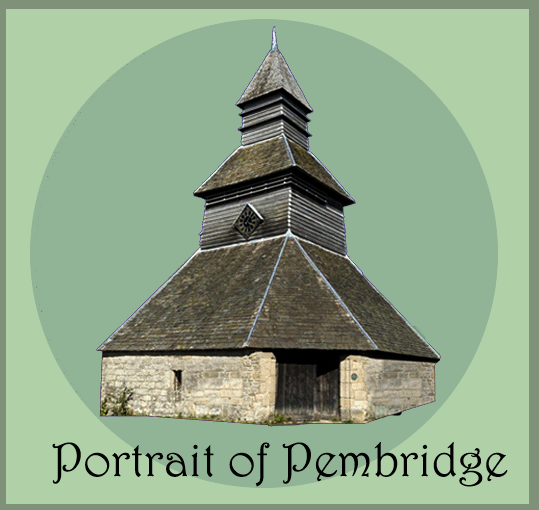The Rare Black Poplars of Pembridge Parish
Having been Pembridge Parish Tree Warden for over 30 years, I have discovered that there are 6 veteran Black Poplars in the parish.
I am talking about the true Native Black Poplar (NBP) Populus nigra betulifolia, said by the Forestry Commission to be the rarest timber tree in the country, with just over 6000 ancient and veteran NBP’s left in the UK. There are just over 100 left in the whole county.
The NBP is completely different to the thousands of Hybrid poplars that have been planted over the last 200 years throughout the country. It is the wild poplar that established after the retreat of the last Ice Age (together with the Birch, Willow, Aspen and Alder) The NBP was eventually adapted for use by humans, and used for hundreds of years before they were crossed with and American Poplar to produce faster growing and more useful timber. Because they have not been planted for many years they have almost become extinct.
NBP have Male and Female trees, with possibly only 600 Females left in the UK (They were cut down because of the number of fluffy seed that they produce). So, few viable seeds were produced, and planting was done by cuttings (all those years ago). This has led to virtual inbreeding.
This tree, one of a group of pollards (Ash, Willow and NBP) is situated just 30 yards from a public byway in the hamlet of Bearwood. The lovely old tree has been carefully recorded and placed on the Woodland Trust Ancient Tree Inventory Website as have all the other NBP’s in the parish. Other items were also recorded, such as Girth at Breast Height (5.53 metres) and-‘Holes or water pockets, Hollowing branches, Decaying wood in the crown, Decaying wood on the ground, Hollow trunk ’
We have discovered that this is a male tree (red catkins) and having taken part in a Tree Wardens project to identify DNA of all the NBP’s in the County, we know it is Clone 23 (the most common clone (of 9) in the County)
The Hollow trunk was found to (and still does) house Barn Owls and on one trip we were delighted to find a Poplar Hawk Moth.
The shape of the tree illustrates an interesting history – It is currently known as a ‘Lapsed Pollard’ -cutoff at about 10 feet to enable the shoots to grow again above the level of grazing cattle. These shoots were carefully managed in several different ways: Year 1 ‘shredded’ and used as fodder or made into hay. 2-3 year (Arrows on the Mary Rose) thatching spars, wattle and hurdles, 3-5 year hedging stakes, feed racks. 5-12 year selected poles until the final poles were left to be 18-foot Hop poles (as with this tree)
A very similarly managed tree is situated at Weston. Both have been carefully managed (50% reduction) by tree surgeons to extend their lives.
Elsewhere in Bearwood are 3 veteran Maiden NBP trees. This one situated in an old orchard. It shows 4 typical characteristics of NBP’s - a ‘leaning’ tree, downward sweeping branches, very knobbly bark and lack of mistletoe. This one is also male and clone 23.
The Maiden trees have been managed differently to the Pollards in that they have been left to grow into a full canopy tree, originally for use as a timber tree. The timber was used to create beams for building (seen today at Dunkertons and a house at Moorcourt) Cruck beams for houses and barns (Cholstrey, Leominster) and sawn into boards for multiple use in barns (The Leen) and in the first war for ammunition boxes and coffins (this decimated the population of NBP’s)
The last veteran Pembridge NBP can be seen at the eastern entrance to the village and has been managed in a third way- Coppicing, that is; cut off at the base and then the shoots carefully protected from stock. They were managed in a similar way to ‘Pollards’ until the final 4 poles were either cut at 18 feet or left as timber trees (as in this case). This tree is the rarest of the rare! A male tree but Clone 29! (only 12 more cl. 29 trees in the whole of Herefordshire)
I am pleased to say that several parishioners have been busy over the last 30 years and we now have quite a healthy population of young NBP’s carefully grown from cuttings. Some of these are approaching 40 feet high and notable ones are growing at Bearwood, Broxwood, Leen, Moseley, near the Village Hall and elsewhere. Many more are following on. So at least in Pembridge the species is saved from extinction.
Ref: The Herefordshire Black Poplar Project. Currently run by The Herefordshire Tree Wardens with help from the Herefordshire Wildlife Trust, The Woodland Trust and Herefordshire County Council. This project has run for over 30 years and seeks to identify, protect and expand the population of NBP’s in Herefordshire. So far over 120 NBP ‘s have been identified, sexed and DNA tested, 2000 cuttings taken and planted in over 120 Herefordshire Parishes. 9 clones have been identified (including some unique Herefordshire ones) and a Clone bank has been established on a HWT reserve (Oak Tree Farm)
https://www.herefordshirewt.org/planting-black-poplars
Further reading: The Black Poplar, Ecology, History and Conservation. Dr Fiona Cooper
Windgather Press 2006




